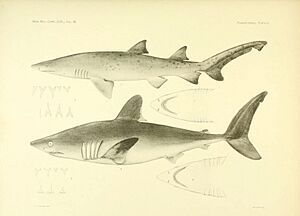Mediterranean sand tiger shark facts for kids
Quick facts for kids Carcharias taurus europaeus |
|
|---|---|
 |
|
| An illustration of a sand tiger shark (top) | |
| Conservation status | |
| Scientific classification |
|
| Kingdom: | Animalia |
| Phylum: | Chordata |
| Class: | Chondrichthyes |
| Order: | Lamniformes |
| Family: | Odontaspididae |
| Genus: | Carcharias |
| Species: | |
| Subspecies: |
C. t. europaeus
|
| Trinomial name | |
| Carcharias taurus europaeus |
|
The Mediterranean sand tiger shark (Carcharias taurus europaeus) was a group of sand tiger sharks. These sharks used to live in the Mediterranean Sea.
Contents
What Happened to the Mediterranean Sand Tiger Shark?
Scientists believe the Mediterranean sand tiger shark is now extinct. This means there are no more of these sharks left alive. The last time one was definitely seen was in 2003.
Why Did They Disappear?
By 2001, there were fewer than 200 of these sharks left. Their numbers kept dropping, and they had very few babies. This made it hard for the population to survive.
It was also tricky to tell them apart from a similar shark. This shark is called the smalltooth sand tiger shark. So, some sightings might have been of the wrong shark.
Where Did They Live?
Scientists studied records from 200 years. They found information about these sharks in 31 places. They also looked at 54 different reports.
These records showed that the sharks were seen in certain areas. They were often found in the southwestern Mediterranean Sea. They also appeared in the eastern Adriatic Sea. Young sharks were seen in these areas too.
How Are They Related to Other Sharks?
Scientists are still learning about the genes of sand tiger sharks. Recent studies suggest the Mediterranean sand tiger shark was related to sharks from the Western Indian Ocean. These are called Carcharias taurus tricuspidatus.
A Journey Through Time
Experts think these sharks traveled a long way. During the Ice Age, a cold ocean current might have weakened. This allowed sharks from the Indian Ocean to swim into the Atlantic Ocean.
Some of these sharks got stuck in the Atlantic. They likely moved north along the coast of West Africa. From there, they probably swam into the Mediterranean Sea.


